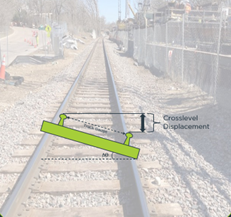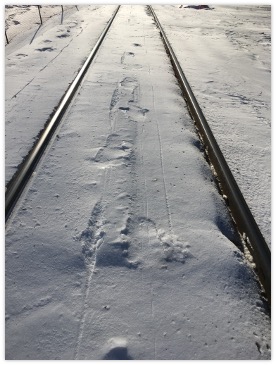Staying On Track: Wireless IoT in Adjacent Construction – Enhancing Efficiency, Safety, and Resource Conservation
In the dynamic realm of urban infrastructure expansion, there are few challenges as intricate and demanding as adjacent construction projects. Particularly, when these projects involve the proximity of new infrastructure to existing critical transportation arteries, engineers face unique challenges. In this article, we delve into a compelling case study: the construction of a light rail extension adjacent to a heavily utilized freight rail corridor in Minneapolis, Minnesota. This endeavor called for the utilization of innovative wireless monitoring solutions to address complex challenges, ensuring the safety and success of this ambitious urban infrastructure project.
The Project: The METRO Green Line Extension, also known as the Southwest Light Rail Project, extends the existing METRO Green Line in Minneapolis. This 14.5-mile extension project introduces 16 new stations, connecting downtown Minneapolis, downtown St. Paul, and various communities across the region. As a part of this massive $2.75 billion venture, a 30-40ft deep excavation of a ¾-mile-long tunnel took place directly adjacent to an active freight rail track. Monitoring this track’s stability amid the excavation was crucial to maintain both operational integrity and safety.
Challenge: Monitoring experts at Terracon were tasked with keeping a watchful eye on the tracks in order to keep the trains running safely as the construction project progressed. This meant finding a monitoring solution to provide regular updates in challenging conditions. These challenges were exacerbated by Minnesota’s harsh weather conditions. Initially, a MEMS Tiltmeter wired monitoring system was deployed to monitor track movement. However, this system proved sensitive to physical damage and moisture ingress?? intrusion. Its high physical profile also made it susceptible to impact damage from trains and track maintenance equipment. The team also deployed Automated Motorized Total Stations (AMTS), but these required a line of sight to the target/prism, which often obstructed by snow during the winter. Additionally, high power consumption was a concern.
Alternative Solution: Terracon engineers therefore sought an alternative solution that could withstand the rigors of the project. They began monitoring a 100ft length of track using Senceive Nano Triaxial Tilt Sensor Nodes and FlatMesh Gateway, a waterproof and wireless system. With tough enclosures and no trailing wires, the sensors proved resilient to the impact of trains and other machinery, and withstood the rigors of the Minnesota weather. Even with the sensors buried under several inches of snow the system continued to relay data to remote stakeholders via cellular communications gateways.

What Was Measured: The wireless monitoring system was employed to measure cross-level displacement and track “twist” in inches, and estimated settlement profiles as supplemental information. Measurements were taken every 5 minutes at 10-ft intervals, ensuring adherence to the published Federal Railroad Administration (FRA) threshold limits.
Outcome: The introduction of the wireless monitoring system allowed for direct measurements of tilt and twist every 5 minutes, even in the harshest weather conditions. Automated alert warnings were triggered if movement exceeded threshold values. The efficiency and economy of the Senceive system proved to be a game-changer, enabling collection of data from many more locations than was achieved using alternative methods.. Luke Hanson, PE, Project Manager at Terracon, lauded the system’s wireless nature, eliminating the hassles associated with installing and maintaining wired solutions.
Three cellular communications gateways collated and transmitted data from the sensors. Powered by solar panels and internal batteries, the gateways proved to be a reliable link between the site and WebMonitor , the cloud-based portal used by engineers to access the data. . Reporting frequencies and other settings could be adjusted remotely via the WebMonitor
, the cloud-based portal used by engineers to access the data. . Reporting frequencies and other settings could be adjusted remotely via the WebMonitor platform.
platform.

“The biggest thing is that the project owner and railroad are really happy and comfortable with the type of information we’re able to provide to make sure that the track is safe for trains to pass,” mentioned Luke Hanson. The WebMonitor App allowed owners and team members to access real-time information, so quick decisions could be made more efficiently to help ensure safety.
The wireless monitoring system enabled the construction team to keep the tracks open and operating safely throughout the tunneling and excavation work. It provided crucial insights into track movement and allowed engineers and stakeholders to proceed with confidence. It ensured the safety of train operations and minimized the risk of disruption.
Conclusion: The successful integration of wireless IoT technology into this adjacent construction project demonstrated the immense potential of innovative remote monitoring solutions in urban infrastructure development. By enhancing safety, providing real-time data, and reducing maintenance hassles, projects like the METRO Green Line Extension can proceed smoothly while simultaneously reducing risk. Such technologies not only ensure the preservation of existing infrastructure but also facilitate progress in urban development, offering a promising path for future construction endeavors. The construction industry is evolving, and wireless IoT is at the forefront, reshaping the way projects are managed and ensuring a safer, more efficient future for urban expansion.

For more information on this project, watch this with Luke Hanson, PE, Project Manager at Terracon and Dan Miller, Head of Americas at Senceive
Featuring a Q&A session about the project
source https://csengineermag.com/staying-on-track-wireless-iot-in-adjacent-construction-enhancing-efficiency-safety-and-resource-conservation/
تعليقات
إرسال تعليق